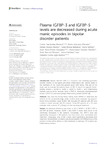Mostrar o rexistro simple do ítem
Plasma IGFBP-3 and IGFBP-5 levels are decreased during acute manic episodes in bipolar disorder patients
| dc.contributor.author | Fernández-Pereira, Carlos | |
| dc.contributor.author | Penedo, María Aránzazu | |
| dc.contributor.author | Alonso-Núñez, Adrián | |
| dc.contributor.author | Rivera-Batanás, Tania | |
| dc.contributor.author | Viétez, Irene | |
| dc.contributor.author | Prieto-González, José María | |
| dc.contributor.author | Vilariño-Vilariño, María Isabel | |
| dc.contributor.author | Olivares, José Manuel | |
| dc.contributor.author | Ortolano, Saida | |
| dc.contributor.author | Agís-Balboa, Roberto Carlos | |
| dc.date.accessioned | 2024-05-30T05:45:30Z | |
| dc.date.available | 2024-05-30T05:45:30Z | |
| dc.date.issued | 2024-04-24 | |
| dc.identifier.citation | Fernández-Pereira C, Penedo MA, Alonso-Núñez A, Rivera-Baltanás T, Viéitez I, Prieto-González JM, Vilariño-Vilariño MI, Olivares JM, Ortolano S, Agís-Balboa RC. Plasma IGFBP-3 and IGFBP-5 levels are decreased during acute manic episodes in bipolar disorder patients. Front Pharmacol. 2024 Apr 24;15:1384198. | es_ES |
| dc.identifier.issn | 1663-9812 | |
| dc.identifier.uri | http://hdl.handle.net/2183/36722 | |
| dc.description.abstract | [Abstract] Introduction: Bipolar disorder (BD) is a recurrent and disabling psychiatric disorder related to low-grade peripheral inflammation and altered levels of the members of the insulin-like growth factor (IGF) family. The aim of this study was to evaluate the plasma levels of IGF-2, insulin-like growth factor-binding protein 1 (IGFBP-1), IGFBP-3, IGFBP-5, IGFBP-7, and inflammatory markers such as tumor necrosis factor α (TNF-α), monocyte chemoattractant protein 1 (MCP-1), and macrophage inflammatory protein 1β (MIP-1β). Methods: We used the Young Mania Rating Scale (YMRS) to determine the severity of the symptomatology, while proteins were measured by enzyme-linked immunosorbent assay (ELISA). We included 20 patients with BD who suffered a manic episode and 20 controls. Some BD patients (n = 10) were evaluated after a period (17 ± 8 days) of pharmacological treatment. Results: No statistical difference was found in IGF-2, IGFBP-1, IGFBP-7, TNF-α, and MIP-1β levels. However, IGFBP-3 and IGFBP-5 levels were found to be statistically decreased in BD patients. Conversely, the MCP-1 level was significantly increased in BD patients, but their levels were normalized after treatment. Intriguingly, only IGFBP-1 levels were significantly decreased after treatment. No significant correlation was found between the YMRS and any of the proteins studied either before or after treatment or between IGF proteins and inflammatory markers. Discussion: To some extent, IGFBP-3 and IGFBP-5 might be further explored as potential indicators of treatment responsiveness or diagnosis biomarkers in BD. | es_ES |
| dc.description.sponsorship | This research was funded by Instituto de Salud Carlos III (ISCIII) through the projects PI18/01311 and PI22/00827 (co-funded by the European Union) given to RA-B and SO, respectively. This research was partially funded by the Ministry of Science and Innovation through the project PID2022-138936OB-C31 (co-funded by the European Regional Development Fund (FEDER), “A way to make Europe,” UE) given to RA-B. CF-P was supported by an “Investigo Program” TR349V-2022-10000052-00 predoctoral contract from Conselleria de Emprego, Xunta de Galicia, and grant IN607B-2023/08 from GAIN, Xunta de Galicia, to SO. | es_ES |
| dc.description.sponsorship | info:eu-repo/grantAgreement/ISCIII/Programa Estatal de Fomento de la Investigación Científica y Técnica de Excelencia/PI18%2F01311/ES/BUSQUEDA DE BIOMARCADORES Y ESTUDIO DEL MICROARNOMA DEL DETERIORO COGNITIVO ASOCIADO A LA DEPRESION | es_ES |
| dc.description.sponsorship | info:eu-repo/grantAgreement/ISCIII/Programa Estatal para Impulsar la Investigación Científico-Técnica y su Transferencia/PI22%2F00827/ES/Validación de biomarcadores pronósticos para la Enfermedad de Fabry | es_ES |
| dc.description.sponsorship | info:eu-repo/grantAgreement/AEI/Programa Estatal para Impulsar la Investigación Científico-Técnica y su Transferencia/PID2022-138936OB-C31/ES/EVALUACION DEL DETERIORO COGNITIVO (SCREENING Y PROGRESION) USANDO INTELIGENCIA ARTIFICIAL Y BIOMARCADORES EPIGENOMICOS EN POBLACION DE ANCIANOS (COGNISANCE) - SP1 BIOMARCADOR | es_ES |
| dc.description.sponsorship | Xunta de Galicia; TR349V-2022-10000052-00 | es_ES |
| dc.description.sponsorship | Xunta de Galicia; IN607B-2023/08 | es_ES |
| dc.language.iso | eng | es_ES |
| dc.publisher | Frontiers | es_ES |
| dc.relation.uri | https://doi.org/10.3389/fphar.2024.1384198 | es_ES |
| dc.rights | Creative Commons Attribution 4.0 International License (CC-BY 4.0) | es_ES |
| dc.rights.uri | http://creativecommons.org/licenses/by/3.0/es/ | * |
| dc.subject | Young Mania Rating Scale | es_ES |
| dc.subject | Bipolar disorder | es_ES |
| dc.subject | Inflammation | es_ES |
| dc.subject | Insulin-like growth factor 2 | es_ES |
| dc.subject | Insulin-like growth factor-binding proteins | es_ES |
| dc.subject | Macrophage inflammatory protein 1 beta | es_ES |
| dc.subject | Monocyte chemoattractant protein 1 | es_ES |
| dc.subject | Tumor necrosis factor alpha | es_ES |
| dc.title | Plasma IGFBP-3 and IGFBP-5 levels are decreased during acute manic episodes in bipolar disorder patients | es_ES |
| dc.type | info:eu-repo/semantics/article | es_ES |
| dc.rights.access | info:eu-repo/semantics/openAccess | es_ES |
| UDC.journalTitle | Frontiers in Pharmacology | es_ES |
| UDC.volume | 15 | es_ES |
| UDC.startPage | 1384198 | es_ES |
| dc.identifier.doi | 10.3389/fphar.2024.1384198 |
Ficheiros no ítem
Este ítem aparece na(s) seguinte(s) colección(s)
-
GI-GIGG - Artigos [115]







